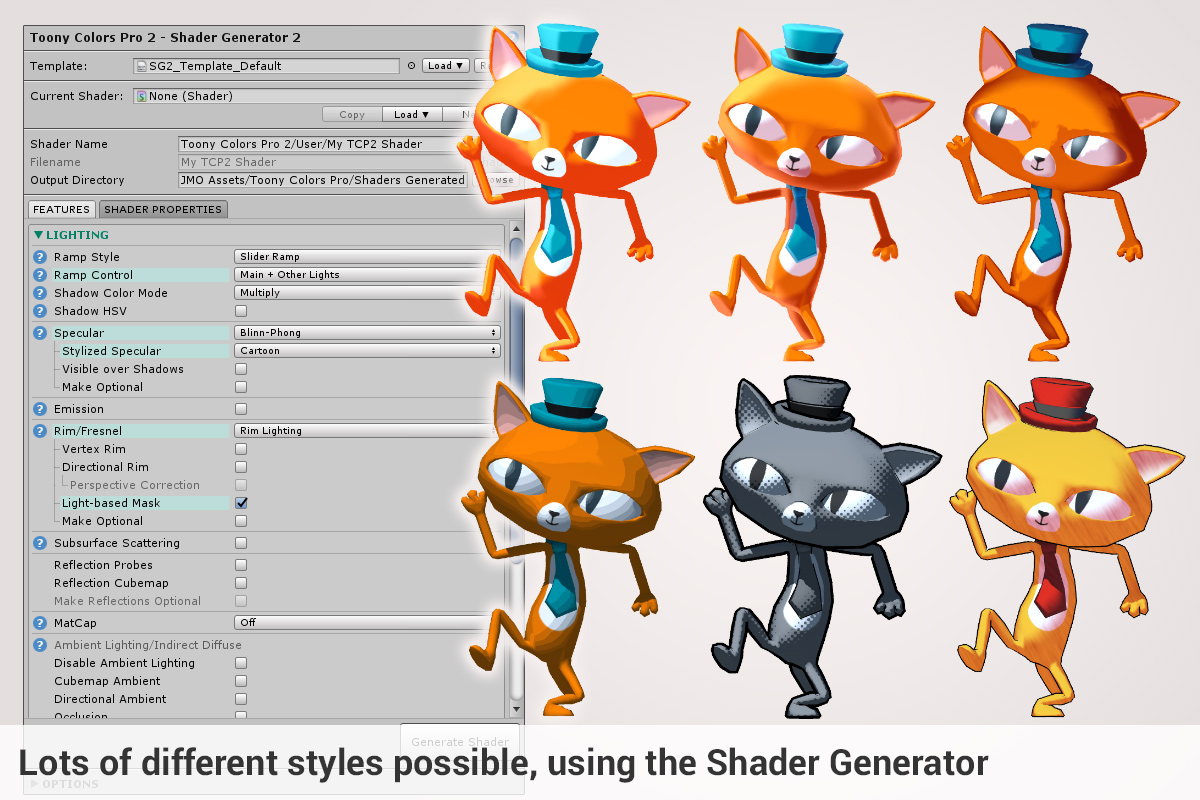

It is a much more flexible system that remains as simple as it was to enable features, but allows further customization of various properties of the resulting shader.įor example, you can change options for any texture used (enable/disable tiling/offset, use scrolling UVs, use screen-space UVs.), or use another data source (e.g. The Shader Generator 2 beta is currently available as of version 2.4.0. UV2: use the vertex second texture coordinates as normals.Tangents: use the vertex tangents as normals (will prevent bump maps and anisotropic specular from working).

Vertex Colors: use the vertex colors as normals.Regular: use the regular vertex normals.Correct Z Artifacts: allows you to tweak the outline extrusion to correct artifacts from complex models.Constant Size Outline: outline size will stay the same relatively to the screen.Texture Outline LOD: defines the mip map level from which to sample the texture color (higher = more blurring).Outline Color From Texture ( Desktop only): takes the outline color from the main texture (averaged and multiplied with the outline color).Outline Width: defines how much to extrude the mesh from the vertex normals to draw the outline.Outline Color: alpha can control opacity depending on the blending mode selected with Blended Outlines.Blended: allows you to set a blending mode to the outlines, to make them transparent for example.Unity then loads an internal shader variation based on the settings chosen, just as it regularly does to turn lightmaps on or off for example (using multi_compile directive) shader file depending on the selected features (outlines for example) Internally the shader selection works in two steps: You can then select the options you want for your material (bump, specular, rim lighting, outlines.) and it will automatically choose the correct shader, making sure you don't have any unused feature loaded. TCP2 will additionally load the relevant Outline shader if that feature is enabled.Īssign one of the Unified Shader to your material(s) depending on the device you target: Toony Colors Pro 2 > Standard PBS (Specular) for the Specular workflowįrom there, similarly to Unity's Standard shader, the correct subshader will be used based on the texture maps and features used, as well as the target platform (meaning that the mobile version of the shaders will automatically be loaded when targeting mobile devices).Toony Colors Pro 2 > Standard PBS for the Metallic workflow.
TOONY COLORS PRO BACKFACE CULLING CODE
Shader Generator: more features to choose from, and get the ultimate stripped-down shader with just the code you needĪssign the following shaders depending on the wanted workflow: Stylization in 1 click: the shader will get settings defined for a material using the default Standard shader unlike Standard where everything has specular and reflections, you can entirely disable these features in Legacy thus resulting in a faster shader Higher Cost: the Standard shader generally requires more GPU power than the Legacy ones (even though there's also a mobile version)īetter Performance: e.g. Less consistency: you may have to readjust material settings so that they fit in each environmentĪutomatic mobile version: the correct shader is loaded internally depending on the target platform

comic-book like visuals using features like halftone or sketch features Limited value ranges: you can't go too much outside the "physical" values and get extreme results (that's actually the whole point of PBS!) Works in all lighting settings: no need to do further tweaks to materials once they're properly configured Longer material setup: more control means more settings to adjust! More control: you can precisely tweak all values to get the exact look wanted Less stylization options: features like sketch or textured threshold are not supported in the PBS shaders

Here is a pros/cons list that can help choosing between either workflow: Standard PBSĮasier material setup similar to Unity's Standard shader, with additional stylization options In such cases, using PBS shaders should be avoided in favor of the Legacy ones. Choosing between the two workflows might not be as easy as it seems: because TCP2 is used to get stylized visuals, there may be some cases where you want to avoid replicating the physical reality of light interaction.


 0 kommentar(er)
0 kommentar(er)
